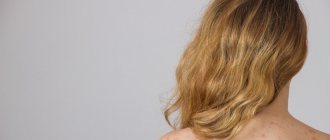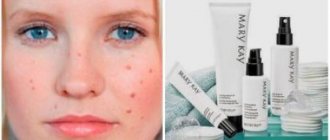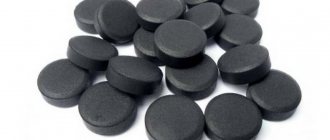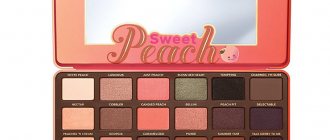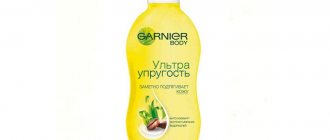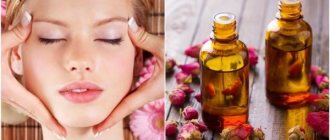In summer, the problem of oily shine and increased activity of the sebaceous glands is much more acute than at any other time of the year. This is especially true for those with oily skin types. The fact is that under the influence of ultraviolet rays and high air temperatures, the sebaceous glands begin to work much more actively. As a result, an unaesthetic oily sheen and numerous inflammations appear on the surface of the skin, which can ruin any image. We will not leave you in the lurch with this problem! We tell you how to properly care for oily skin during the summer months.
Types of oily facial skin
Oily skin is called seborrhea. She is characterized by:
- enlarged noticeable pores;
- dense and pronounced relief, lack of smoothness;
- acne;
- oily shine;
- dull gray-yellow color.
With seborrhea, blush practically does not appear, because blood circulation is slowed down.
This type, depending on the composition of sebum (sebum), comes in three types:
- Liquid seborrhea. Sebum consists of unsaturated fatty acids. The face begins to shine almost immediately after washing or cleansing, due to increased sebum secretion. The pores are noticeable, but they are empty and unclogged. There are no black and white dots (comedones and milia). A comforting fact: such skin does not experience inflammation due to clogged pores.
- Thick seborrhea. Sebum consists of saturated fatty acids with particles of exfoliated epithelium. It is thick and clogs pores. Because of this, comedones, milia, and subcutaneous areas appear, often with inflammatory processes. The advantage is the absence of greasy shine.
- Mixed seborrhea. Those with this subtype are the least fortunate. Oily shine and acne are present at the same time. This type of skin requires especially careful care.
The type of seborrhea is a constant phenomenon that changes in 90-95% of cases only with age. As a rule, it is a combination type, when oily skin is present on the face in the T-zone: forehead, nose, chin.
Seborrhea has temporary problem conditions:
- Dehydration. Moisture deficiency develops with any type of seborrhea, because lard is not water. As a result, skin turgor decreases - wrinkles, sagging, and tightness appear. Oily skin needs constant hydration.
- Violation of the lipid barrier. This condition occurs in those with thick and mixed seborrhea. It manifests itself as dryness, irritation, peeling and itching. Oily skin begins to behave like dry skin, and this leads to mistakes in choosing care products by type.
ATTENTION!
Ekaterina Imshenitskaya
Unsaturated fatty acids create an epidermal barrier. Therefore, its violation does not occur with liquid seborrhea.
- Acne. This disease comes in inflammatory (acne, pimples) and non-inflammatory (comedones, milia) forms. If it is present, oily skin is called problematic.
Ekaterina Imshenitskaya
Seborrhea is not a disease. It is impossible to exchange therapy from one skin type to another. Problematic conditions need to be treated and their occurrence must be prevented.
Why does skin become oily?

Excess sebum is associated with increased work of the sebaceous glands. The reasons for increased sebum secretion may be:
- heredity;
- hormonal disorders;
- improper care;
- Unhealthy Lifestyle.
If your direct relatives, including grandparents, had oily skin, then there is a high probability that you inherited it too. This type does not change with age. The sensitivity of the sebaceous glands to hormones and a predisposition to certain diseases are also genetically transmitted. That is, the cause of acne may be heredity.
Another factor is hormonal imbalances. Up to 80% of teenagers and young adults aged 15-24 experience acne due to excess testosterone. Prolactin, insulin, cortisol, thyroid hormones, etc., also affect the secretion of the sebaceous glands and the development of inflammation. Hormonal imbalance in adulthood can be a consequence of diseases or temporary conditions (pregnancy, menstruation). First of all, the cause is identified, because without eliminating it, inflammation will reappear.
IMPORTANT!
Ekaterina Imshenitskaya
Don't try to treat acne on your own. If you have frequent inflammations, get examined by specialists:
- dermatocosmetologist;
- endocrinologist;
- gynecologist;
- gastroenterologist.
Errors in care also lead to oily skin becoming problematic. What not to do with seborrhea:
- Wash with hot water. High temperature increases the secretion of the sebaceous glands.
- Use alcohol-containing and alkaline products to clean and protect against bacteria. They dry out the skin and disrupt the lipid barrier. Itching, irritation, and inflammation appear due to infections.
- Scrub and exfoliate frequently. The face reacts to microdamages with increased sebum production.
- Use cosmetics that are not suitable for your skin type. Their active components are not absorbed by dermal cells. Such cosmetics clog pores and lead to the development of acne.
- Neglect hydration. Dehydrated, oily skin leads to dermatological problems that need to be treated. For seborrhea, facial moisturizer is needed even in winter.
Poor nutrition and poor environment affect the condition of the skin, especially oily skin. Baked goods, soda, sweets and alcohol provoke the development of inflammation. Smoking and polluted air worsen complexion and clog pores.
Caring for oily skin should solve 3 problems:
- cleansing of excess sebum;
- getting rid of comedones;
- decreased secretion of the sebaceous glands.
Additional care at home
As additional treatments for oily skin that can be done at home, the main ones are masks. However, before applying the mask, it is necessary to steam so that the open pores allow the nutrients of the mask to penetrate deeper into the skin.
Steaming
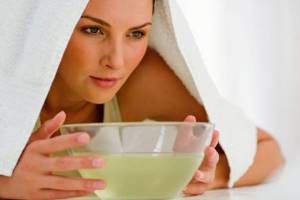
To steam your face, you can buy a special device, or you can use improvised means. Pour water into a small saucepan and add some dried herbs. For oily skin, lavender, rosemary and thyme are suitable. Bring water to a boil and remove from heat. Now, cover your head with a towel and allow the steam to penetrate and work on your skin for 5-8 minutes. Close your eyes and relax. This process opens the pores and makes your face ready for masks and other treatments.
Important!
The steaming procedure is contraindicated for those who have spider veins on their face
Homemade masks and lotions

Experts say that homemade face masks are one of the most effective and safest ways to make your face clean, matte and beautiful. Many cosmetic care products, unfortunately, dry out the skin and only make the situation worse. But homemade masks that you make with your own hands contain natural and fresh ingredients that carefully reduce the secretion of sebum and fat. The main rule is regular care.
Attention!
If you have acne, you should not use exfoliating masks.
Clay mask
This mask is considered the most effective for oily skin. Take a small bowl and add two spoons of clay, two spoons of tomato puree and a teaspoon of fresh yogurt. Now add a few drops of lemon juice to this mixture and mix well until it becomes smooth. You can also add a little water if the consistency is too thick. The consistency of this mask should not be too thick or too thin, it should be smooth and moderately thick.
Now, using a brush, apply the mask evenly over the face and neck, avoiding the areas around the eyes. Dip two cotton pads in rose water or cucumber juice and place it on your eyes.
Relax and wait 15 minutes for the mask to dry. Don't leave the mask on for a long time as this can cause your skin to tighten, resulting in fine lines.
After fifteen minutes, gently wipe the mask with damp cotton swabs and rinse your face with cold water.
Soda mask
This simple mask nevertheless has an excellent effect of narrowing pores and drying out pimples. Soap a cotton pad well and dip it in baking soda, then thoroughly lubricate your face with the resulting mixture and let it harden. Rinse off with cold water after a few minutes.
Lemon
Regular lemon tightens pores well, whitens and fights oily shine. It is necessary to wipe your face every day for a month with a cotton pad soaked in lemon juice. The effect will be amazing.
Cucumber mask
Cucumber has long been considered a skin care product for oily skin. Mix crushed cucumber with boric acid in a 4:1 ratio and apply to the face. Leave for 20 minutes, then rinse with cool water.
Honey mask
Add steam and drops of grapefruit or lemon essential oil to a tablespoon of natural honey. Apply to facial skin, massage lightly with patting movements and leave for an hour. Then it is recommended to rinse with slightly warm water and apply a non-greasy cream to the skin.
Oatmeal mask
50 grams of oatmeal is mixed with one protein, and then applied to the face for 30 - 40 minutes. Afterwards it is also washed off with cold or slightly warm water.
Lotion
To make lotion for oily skin at home you will need lemon balm, which you can buy at any pharmacy, and vodka. Everything is mixed at a ratio of 1 to 5 and infused for five days. After which it is recommended to wipe your face with this lotion twice a day.
You can read more about homemade face masks here.
Skin cleansing methods
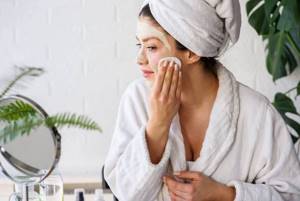
To remove impurities and sebum, daily cleansing is carried out in 2 stages:
- Makeup remover At this stage, use micellar water or hydrophilic oil. They remove sebum and makeup without leaving a sticky film on the face.
- Wash your face with cool water and foam or gel for oily skin.
Do not combine two stages into one - this is not enough to dissolve fat. When washing your face, use sponges that do not scratch the skin, and change them regularly, because bacteria actively multiply in a humid environment.
Use scrubs, peelings and masks 1-2 times a week. They fight hyperkeratosis - thickening of the upper layer of skin, to which the seborrheic type is prone.
Rules for caring for oily skin
Cleansing
It is important to carry out the cleansing procedure competently and not to overdo it. There is an opinion that oily skin needs to be cleansed aggressively, but this is not true. If you cross the line, then dehydration will be added to the problem of fat content. Therefore, you need to treat your skin with care. Give preference to soft products with a delicate formula and light texture. Ideal products are gels and foams for washing, as well as soap with a neutral pH. It is recommended to cleanse twice a day - morning and evening. Try to avoid chlorinated tap water - pass it through a filter. Never wash your face with hot water: it will make the sebaceous glands work even more actively. Cool water should be your friend. For deeper cleansing, use peelings, scrubs, gommages, and clay masks 2-3 times a week.
Toning
Many people advise those with oily skin to avoid alcohol-containing lotions and tonics, as they dry out the skin and can disrupt the hydrolipid mantle. However, such beauty products contain caring ingredients that will prevent the skin from drying out. In addition, it is alcohol-containing lotions that have an antibacterial and disinfectant effect, preventing the growth of bacteria and the appearance of blackheads.
LIFE HACK! If, after using alcohol-containing tonics and lotions, apply a moisturizing cream or serum, there will be no feeling of tightness and dryness
Matting napkins
Make it a habit to carry them with you in your purse. They don't take up much space, but with their help you can quickly refresh your skin, correct your makeup and get rid of oily shine during the day. The wipes contain caring, antibacterial and moisturizing components that prevent the appearance of sebum.
Hydration
Oily skin, like any other type, needs hydration. The main thing is to choose the right remedy. Light fluids, creams, emulsions and serums that do not contain comedogenic components will help to moisturize such skin in the summer. In the composition, look for hyaluronic acid, plant extracts, fruit acids, as well as ingredients that have anti-inflammatory, soothing and mattifying properties. Please note that moisturizers should not contain mineral oil: it causes oily shine and clogs pores. Oily skin doesn't like layering textures, so stick to one product per application. During the day, to refresh, moisturize and tone the skin, use thermal water: it also reduces the activity of sebum production.
Sun protection
As mentioned above, the sun's rays provoke increased activity of the sebaceous glands, hence the appearance of oily sheen. Therefore, it is important to protect your skin from the sun. There are special Sanskrins designed specifically for oily facial skin: they contain not only protective components, but also caring and anti-inflammatory substances (for example, zinc oxide). The SPF level depends on the skin: for fair skin that burns easily, it is recommended to use SPF 50, for slightly dark skin - SPF 30, and for very dark skin - SPF 15. For oily skin, the texture of the sunscreen is also important: like all products in your arsenal , Sanskrin should be as easy as possible. Sun cream is applied 30 minutes before going outside.
Makeup
In summer, it is recommended to abandon foundation creams or use those that are designed specifically for oily skin, can control the appearance of oily shine and do not clog pores. Instead of foundation, you can use a mineral primer, BB cream or mineral loose powder. They mask skin imperfections well, but do not clog pores.
Cosmetics
Skin care products are divided into 3 groups according to the degree of active substance content:
- ordinary cosmetics that are sold in stores;
- cosmeceuticals may contain drugs and are sold in pharmacies;
- Professional products are used in salons and clinics.
IMPORTANT!
Ekaterina Imshenitskaya
Purchase products of the second and third groups only after consultation with a cosmetologist to avoid complications.
I will tell you how to choose seborrhea care products from those available in stores.
Creams
Don't skip the cream for your daily care. It creates a protective barrier and retains moisture. To get a mattifying effect, choose products with zinc, sulfur, camphor, and enzymes. Chamomile, thyme, iris, sage, and witch hazel regulate the activity of the sebaceous glands.
IMPORTANT!
Ekaterina Imshenitskaya
Choose creams with a light texture: gel, fluid, emulsion, etc. Look for the inscription “oil-free” on the label.
I do not recommend using foundation for seborrhea. If you cannot do without it, use a light product with a mattifying effect and apply it in a thin layer.
Masks
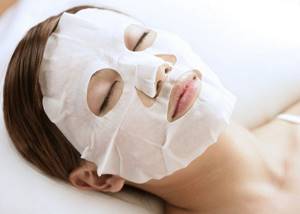
Use masks for deep cleansing of pores 1-2 times a week in the autumn-winter period, and up to 3 times in the heat. These products adsorb sebum and saturate the skin with minerals. Useful for seborrhea:
- dry masks with silicon dioxide, magnesia, sulfur, aluminum silicate;
- products with dirt and silt;
- clay masks.
IMPORTANT!
Ekaterina Imshenitskaya
Keep the mask on your face for 10-15 minutes. Do not let it dry out to avoid dehydration - if necessary, spray your face with thermal water.
Gels
For washing, choose products without aggressive sulfates, because they disrupt the lipid barrier and dry out the skin.
FOR REFERENCE
Ekaterina Imshenitskaya
Sulfates are added to cleansing gels to make them foam more and remove dirt. They are aggressive and soft. The first group includes:
- SLS or Sodium Lauryl Sulfate - sodium lauryl sulfate;
- SLES or Sodium Laureth - sodium laureth sulfate;
- ALS or Ammonium Lauryl Sulfate - ammonium lauryl sulfate;
- ALES or Ammonium Lauleth Sulfate - ammonium laureth sulfate.
Tonics
Tonics differ from lotions in that they do not contain alcohol. They are preferable for daily care for seborrhea. Look for mattifying, astringent and balancing products. Tonics can be replaced with hydrosols based on sage, thyme, mint, and rosemary.
Use lotions for therapeutic care, as they contain active substances in high concentrations: sulfur, camphor, zinc, fruit acids. Do not overdo them so as not to dry out the skin.
Oils
Cosmetic oils dissolve sebum and are easily washed off with water. Hydrophilic mineral-based products gently cleanse the skin and do not destroy the epidermal barrier.
IMPORTANT!
Ekaterina Imshenitskaya
The emulsifier in the oil is a surfactant (surfactant) and should not remain on the face for a long time. Use hydrophilic products only for washing, and not as a mask or lotion.
Serums
Healing serums enhance the effect of the cream, so apply them as a base underneath it. Buy products with an astringent and sebum-regulating effect. During the hot season, serum can be used instead of cream.
Scrubs

Chemical peels based on salicylic, mandelic or fruit acid exfoliate dead cells, cleanse pores and regulate the secretion of sebaceous glands. Alternate them with enzyme products that dissolve sebum. Choose gel-based scrubs with soft exfoliating particles. Don't overdo them.
IMPORTANT!
Ekaterina Imshenitskaya
If redness appears after a scrub or peel, change the product. This is a sign that it removes the lipid barrier.
Women's magazine - Secrets of health and beauty
Oily skin care
Oily skin is the result of increased activity of the sebaceous glands. reasons for this condition.
These include hormonal disorders, an increase in the amount of female sex hormones during pregnancy, and endocrine pathologies, constipation, abuse of spicy, fatty or carbohydrate foods, alcoholic beverages, improper skin care, and increased sensitivity of the sebaceous glands to male sex hormones.
As a result, the excretory ducts of the sebaceous glands expand and viscous sebum is abundantly released from them. At the same time, the skin becomes glossy, shiny, dust easily sticks to it, dead horn cells accumulate, clogging the ducts of the sebaceous glands and forming plugs.
Such skin tolerates adverse atmospheric factors well, but does not resist infection well, and signs of inflammation often appear on it. However, it remains firm and elastic for a long time, wrinkles appear on it later, and it looks better with age.
It is difficult to confuse oily skin with any other skin - it begins to shine almost immediately after washing and looks thick. However, this is true: if you take it into the fold, it will be much more voluminous than the same one on dry skin. Indispensable companions of oily skin are enlarged pores on the forehead, nose and chin - exactly where the most sebaceous glands are located.
Thus, every owner of oily skin faces the following tasks to care for it : promptly remove excess sebum, tighten pores, restore the acidic surface of the skin, disinfect it, and take measures to normalize fat metabolism.
In the morning, washing with warm water (35 °C) and special soap is useful. Liquid soap and gel have proven themselves to be effective in caring for oily skin. Gel is a soap-free washing liquid with the addition of plant components that cleanse the skin, which then needs to be rinsed with water. Such gels may also contain special additives that tighten pores and reduce sebum secretion, for example, thyme, lemon, sage.
Washing with soap can be replaced by rinsing the face with whey, which is then washed off with warm water and refreshed with lotion for oily skin. Rubbing the skin with pieces of ice prepared from herbal infusions has a good effect.
If you have acne, it is useful to wash your face with an infusion of oatmeal (2 tablespoons of rolled oats, 1 teaspoon of salt, pour a glass of boiling water in a thermos, leave for 1 hour) and rinse with acidified water (sour apple peels and lemon peels should be poured with warm water and leave for 2 hours).
After washing, you can use other tonic liquids that refresh oily skin and have a tightening effect. They should not contain alcohol or contain it in very high concentrations. Despite the widespread belief that alcohol-containing tinctures can reduce the process of sebum production, alcohol actually does not affect the functioning of the sebaceous glands, although it dries out the skin.
An excellent choice are tonics containing fruit acids: plant extracts, lactic and citric acids, nettle, burdock, hop leaves, lemon and lingonberry juices, St. John's wort.
They reduce the activity of the sebaceous glands, have a slight whitening effect, facilitate cleansing the skin of dead cells, make it more elastic and protect the sebaceous glands from clogging.
Often used in the care of oily skin, salicylic acid and camphor have a disinfectant and astringent effect, and also restore the acidic reaction of the skin surface.
Interesting numbers
The skin performs protective, respiratory, excretory and heat exchange functions, etc. The temperature of 36.6, which we consider normal, is the temperature outside. The optimum for the functioning of internal organs is 37–38 °C.
In the hot season (with intense sebum secretion), you need to wash your face with gel and liquid soap 2 times a day. In winter, as a rule, it is enough to rinse your face with running water and wipe your skin with lotion or a piece of ice with a decoction of medicinal plants.
After washing, dry the skin with a soft towel and apply the cream for 20 minutes, then remove excess with a damp swab moistened with a special lotion for oily skin.
Lotions can be prepared at home from infusions of herbs and vegetable or fruit juices. For this, oranges, lemons, cucumbers, grapes, quinces, pomegranates, rowan berries, cranberries, tomatoes, melons, and watermelons are used.
Adviсe
♦ It is useful to wipe oily skin in the morning and evening with fresh juice or infusions of St. John's wort, birch leaves, burdock; and to tighten the pores, you can wash your face in the morning with an infusion of chamomile, sage, calendula, and wormwood. A good effect is obtained by rubbing with oregano lotion, for the preparation of which you need to infuse 20 g of the herb in 200 ml of 40% alcohol for 10 days, strain, dilute with water in a ratio of 1: 1 and wipe daily.
♦ For oily skin, soap and salt washes are useful. To do this, moisten a sponge or cotton swab with water, soap it and sprinkle with a small amount of salt. Then carefully, without putting pressure on the skin, wipe oily areas along the massage lines. The foam should be washed off after drying. Salt washes help tighten pores and tone the skin. If irritation occurs during the process, then instead of salt and soap, use equal parts of borax and tea soda.
Several times a day it is useful to wipe oily skin with calendula tincture, vodka diluted with water, salicylic alcohol, 1% ammonia. In order not to deprive the skin of the fat it needs, it is allowed to use a fatty cream 1-2 times a week. 5 minutes before applying this cream, wipe the skin with a mixture of 1 tbsp. l. camphor alcohol and 1 tbsp. l. calendula infusion.
Caring for oily skin includes the use of various creams: medicinal (if the skin has acne), protective, with a matte effect and moisturizing. It is important to remember one thing here: a cream containing more than 30% fat clogs the pores of oily skin, which leads to inflammation and acne. It is especially important to take this into account when choosing decorative cosmetics - foundations and blush.
Creams for oily skin should include the same components as tonics: substances that tighten pores, absorb excess oil, and reduce sebum secretion. These are so-called stearate creams, containing the fatty acid stearine instead of fat, which reduce the shine of the skin and create the necessary acidic reaction on its surface. Fat-free creams are used during the day as a base for makeup.
In addition, creams for oily skin contain substances that absorb excess sebum: white clay (kaolin), talc, starch, and specially developed synthetic substances. Recent developments by cosmetology scientists have made it possible to create creams containing derivatives of zinc, copper, and vitamin B6, which affect the formation of a special enzyme, which ultimately inhibits the functioning of the sebaceous glands.
Oily skin benefits from creams containing salicylic acid and vitamin A, which help reduce the formation of acne, as well as creams with vitamin E, which moisturize and normalize metabolism.
For oily skin, special attention must be paid to facial cleansing - it should be optimized in every possible way, and here you need to make your own efforts and seek help from a cosmetologist. At home, thorough cleansing of the skin for 3-5 minutes is carried out 2 times a day, and once every 7-14 days a soft facial peeling without abrasive particles is necessary, which also has another name - gommage, which is literally translated from French as “eraser” , i.e. purifier. After peeling, apply a mask based on kaolin (white clay) or other substances that tighten the skin.
If you decide to cleanse your face in a beauty salon, it may look like this. A cleanser is applied to the facial skin and removed with a warm, damp towel, damp swab or cosmetic sponge. The client's eyes are covered with damp cotton swabs, after which the skin condition is analyzed under a magnifying glass. Then the skin is steamed with damp warm towels, which are applied to the face 3-4 times, or using special equipment.
Next, a cosmetologist wearing latex gloves, wrapping his fingertips in cotton wool, squeezes out the acne using specific techniques. Facial cleansing can also be done using special tools - acne squeezers. Then the face is wiped with an astringent.
The described procedure is called mechanical (manual) cleaning with steaming , but it can also be done without steaming.
In this case, after cleansing the face, apply a special mask that opens the pores, and at the end of the cleansing, the same one, only tightening it.
If acne is on the surface of the skin, vacuum cleaning . In this case, after steaming or a facial mask, cleanse is done using a special device, into a small nozzle of which, like a vacuum cleaner, all skin impurities are sucked out.
Ultrasonic cleaning is carried out using ultrasound, which has the ability to dissolve accumulations in the sebaceous ducts.
If, in addition to superficial acne, there are also deep acne on the face, then combined cleansing is indicated: manual and vacuum or ultrasonic .
Interesting numbers
From 30 to 100 moles are found on the skin of an adult. But it may also be that their number exceeds 400. British researchers have even identified a connection with the rate of aging of the body.
Periodic exfoliation of the stratum corneum is an integral part of caring for oily skin. Peeling cleanses pores and stimulates cell renewal of the surface layer. In a beauty salon, superficial chemical peeling using vitamin A derivatives (retinoids) is performed once every 4–8 weeks, or a comprehensive cleansing procedure is performed 2–3 times a year. At home, creams and gels containing fruit acids are used. Such procedures maintain the effect obtained in a beauty salon.
Oily skin requires normalization of general metabolism, for which it is useful to introduce into the diet foods containing vitamins A (liver, egg yolk, milk, butter, fish oil, bee bread), B2 (greens, yeast, oatmeal and buckwheat, cheese, vegetables ), C (vegetables, fruits, onions, garlic, sauerkraut, lemon, black currants, oranges, rose hips). It is necessary to pay attention to the functioning of the intestines and avoid constipation.
Share link to article:
Differences in care during the day and evening
Morning care includes:
- washing;
- toning;
- application of base and medications (for inflammation);
- makeup;
- applying cream with ultraviolet protection.
Choose dry decorative cosmetics, preferably mineral-based. It doesn't clog pores or allow makeup to smear. Use primer and mattifying powder. Avoid cream products.
During the day, clean your face, if necessary, with mattifying wipes, and use thermal water to moisturize. These products will not ruin your makeup. Daytime is also suitable for scrubbing and applying masks.
In the evening, remove makeup, wash your face and wipe your face with lotion. Choose a night cream that is moisturizing and fortified.
